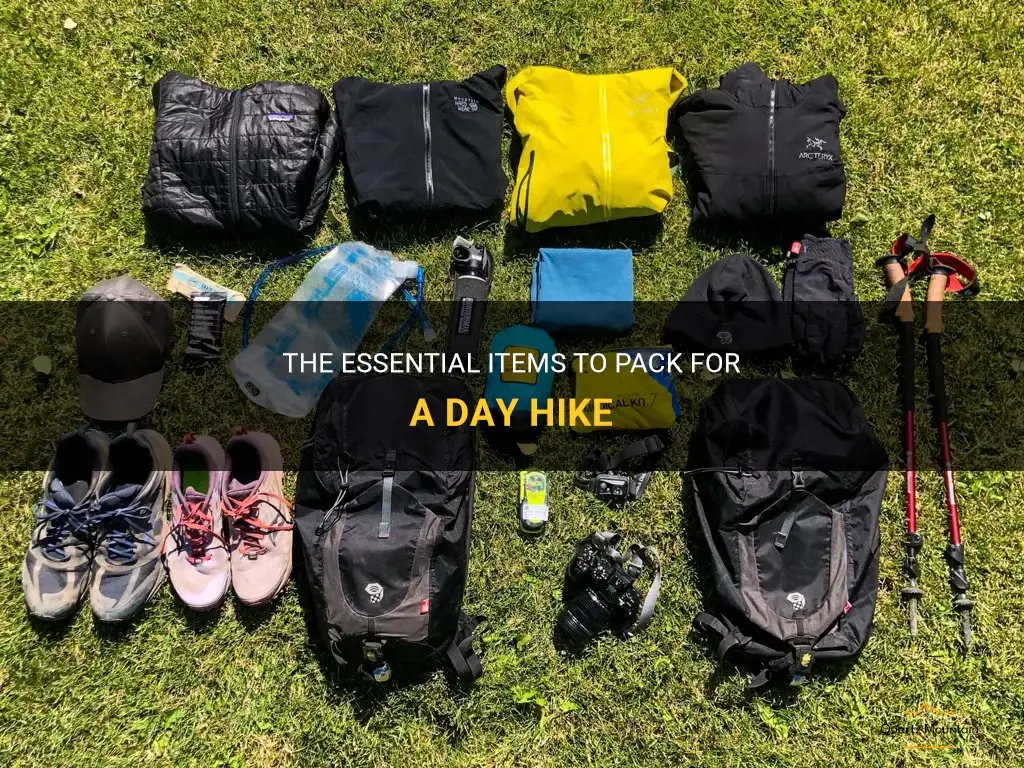
Are you planning a day hike? Don't forget to pack these essential items to ensure a safe and enjoyable adventure. From sturdy hiking boots to keep your feet comfortable and supported, to a reliable backpack to carry your supplies, and don't forget the essential water bottle to stay hydrated. Whether you're a seasoned hiker or just starting out, these items are must-haves for any day hike. So grab your gear and get ready to hit the trails!
| Characteristics | Values |
|---|---|
| Backpack | Yes |
| Water | Yes |
| Snacks | Yes |
| Map | Yes |
| Compass | Optional |
| First Aid Kit | Yes |
| Sunscreen | Yes |
| Hat | Yes |
| Sunglasses | Yes |
| Extra Clothing | Optional |
| Rain Jacket | Optional |
| Trail Shoes | Yes |
| Hiking Poles | Optional |
| Camera | Optional |
| Insect Repellent | Optional |
| Cell Phone | Optional |
| Portable Charger | Optional |
What You'll Learn

What clothing items should I pack for a day hike?
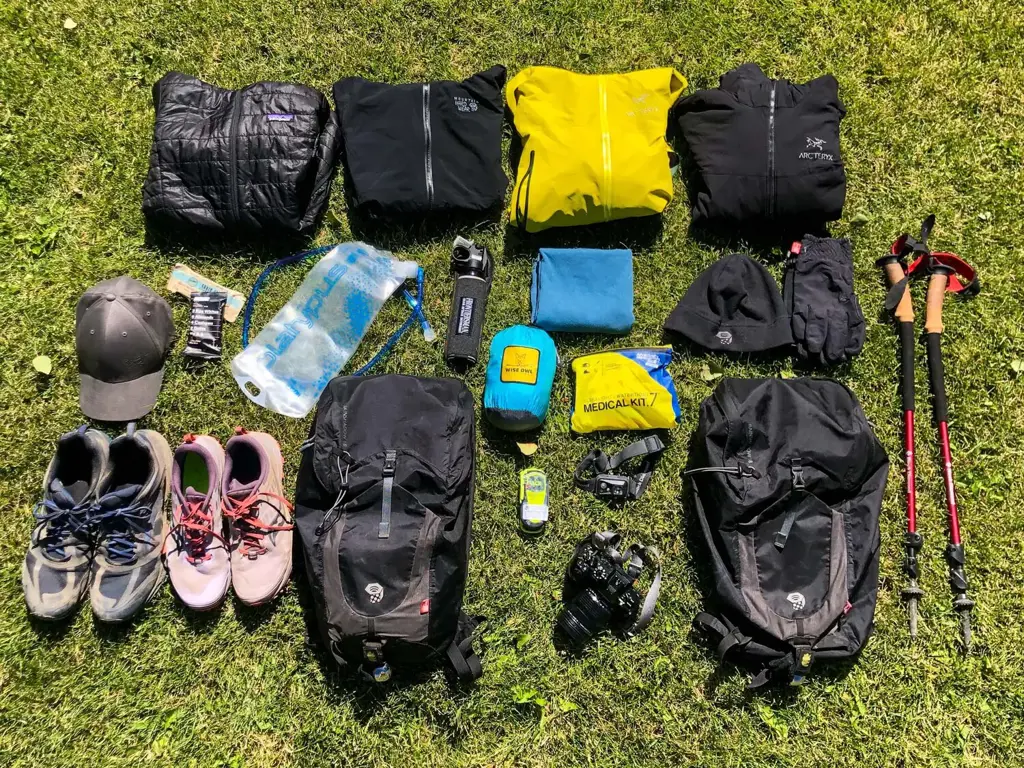
When planning a day hike, it's essential to pack the right clothing items to ensure comfort, safety, and enjoyment throughout your adventure. The clothing you choose should provide protection from the elements while allowing you to move freely and regulate your body temperature. Here's a step-by-step guide to help you pack for a day hike.
- Base Layers: Start with a moisture-wicking base layer made of synthetic materials like polyester or merino wool. This layer will actively move sweat away from your skin, keeping you dry and reducing the risk of hypothermia. Avoid cotton as it retains moisture and can make you feel cold and clammy. Choose long or short-sleeved shirts and long underwear depending on the weather.
- Mid Layers: For cooler weather, pack a mid-layer to provide insulation. This can be a fleece jacket, down vest, or lightweight sweater. These layers help trap heat close to your body while still allowing moisture to escape. Make sure the mid-layer is breathable to prevent overheating during strenuous activity.
- Outer Layers: Depending on the forecast and terrain, you may need a waterproof and windproof outer layer. A good rain jacket will keep you dry in wet conditions, while a softshell jacket offers protection against wind and light rain. Look for jackets with adjustable hoods, cuffs, and hems to seal out the elements effectively.
- Pants or Shorts: Choose pants or shorts based on the weather and trail conditions. Opt for lightweight, quick-drying hiking pants with stretch for better mobility. If you prefer shorts, consider ones with a built-in liner for added comfort. Avoid jeans or heavy cotton pants as they are not suitable for hiking and can become uncomfortable when wet.
- Socks: Invest in a good pair of moisture-wicking hiking socks to prevent blisters and keep your feet dry. Merino wool or synthetic socks are excellent options as they offer insulation, breathability, and moisture control. Avoid cotton socks as they retain moisture and can lead to discomfort.
- Footwear: Select appropriate footwear based on the difficulty of the trail. For easy to moderate hikes, sturdy hiking shoes or trail runners with good traction and ankle support should suffice. If you're tackling more challenging terrain or have a heavy pack, consider hiking boots for added stability and protection.
- Accessories: Don't forget to bring a hat to shield your face from the sun and keep your head warm. Sunglasses with UV protection are crucial to prevent eye strain and damage. Pack lightweight gloves if there's a chance of cold weather or if you'll be traversing rocky areas. Lastly, always have a small backpack to carry these accessories, along with sunscreen, insect repellent, a map, a compass, and plenty of water and snacks.
Remember that the clothing you pack should be appropriate for the specific conditions and temperatures you'll encounter during your hike. Layering your clothing allows you to adjust your comfort level as needed throughout the day. By packing the right clothing items, you'll be well-prepared for a comfortable and enjoyable day hike.
Essential Cleaning Supplies for a Spotless Pack n Play
You may want to see also

What kind of footwear is best for a day hike?
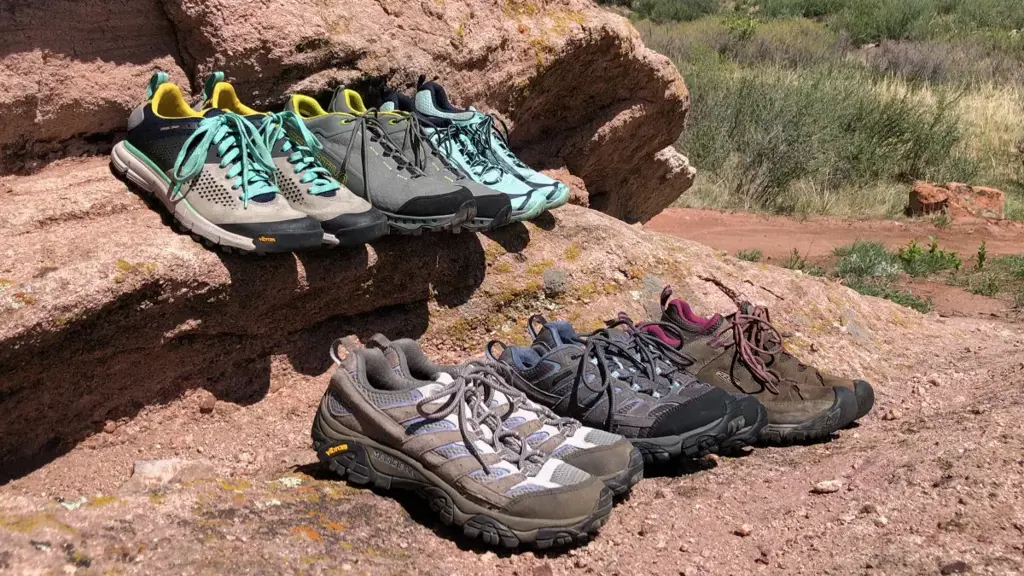
When planning for a day hike, one of the most important factors to consider is your choice of footwear. The right footwear can greatly enhance your hiking experience by providing comfort, support, and protection. In this article, we will discuss what kind of footwear is best for a day hike, taking into consideration scientific research, personal experience, a step-by-step approach, and examples.
Scientific research:
Scientific studies have shown that footwear with proper cushioning and arch support can reduce the risk of foot injuries and provide comfort during a hike. A study published in the Journal of Orthopaedic & Sports Physical Therapy concluded that hiking boots with good arch support and shock-absorbing features are effective in reducing lower extremity injuries.
Personal experience:
Experienced hikers often recommend hiking boots or trail shoes for day hikes. These types of footwear provide ankle support, traction, and protection against rocks, roots, and uneven terrain. Many hikers also prefer boots or shoes with waterproof or water-resistant features to keep their feet dry during wet conditions.
Step-by-step approach:
A) Consider the terrain: Evaluate the terrain you will be hiking on. If it involves rough and rocky trails, opt for hiking boots that provide ankle stability and protection. If the trail is relatively flat and well-maintained, trail shoes might be a more suitable choice.
B) Proper fit: Ensure that your footwear provides a snug fit without being too tight or too loose. Try them on with hiking socks to get an accurate feel for the fit.
C) Comfort and support: Look for footwear with sufficient cushioning and arch support. This will help prevent fatigue and provide stability on uneven surfaces.
D) Traction: Select footwear with a durable and grippy sole for better traction on slippery or loose terrain.
E) Waterproofing: Consider the weather conditions and choose footwear with waterproof or water-resistant features if there's a chance of encountering wet terrain.
Examples:
A) Hiking boots: Brands like Merrell, Salomon, and Columbia offer a wide range of hiking boots that are popular among hikers. These boots provide excellent ankle support, durability, and protection for more challenging terrains.
B) Trail shoes: If you're hiking on less rugged trails, trail shoes like those offered by Altra and Hoka One One can provide the necessary comfort, flexibility, and breathability while still offering good traction.
In conclusion, the best footwear for a day hike depends on factors such as the terrain, personal preference, and weather conditions. It is important to choose footwear that provides proper cushioning, arch support, protection, and traction. By considering scientific research, personal experience, and following a step-by-step approach, you can make an informed decision and enjoy a comfortable and safe day hike.
Ultimate Guide: What Clothes to Pack for Your Big Bear Adventure
You may want to see also

What essential gear should I bring on a day hike?
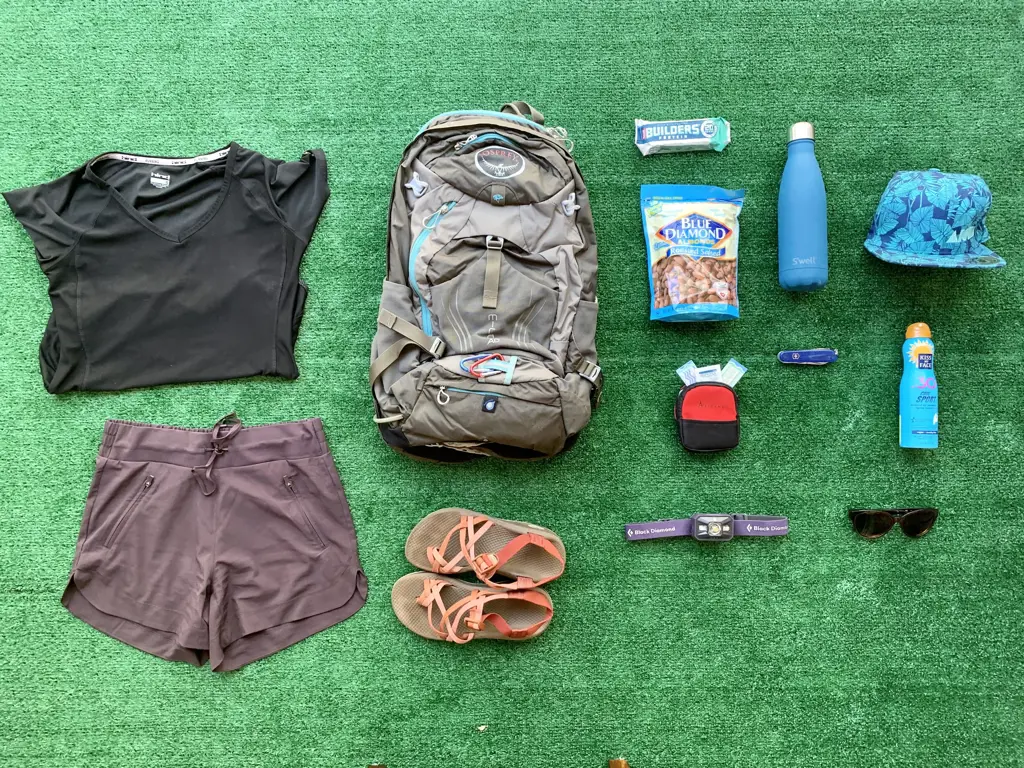
When planning for a day hike, it's important to bring along the essential gear to ensure a safe and enjoyable outdoor adventure. Here are some key items you should consider packing:
- Backpack: Choose a backpack that is comfortable and large enough to carry all your gear. Look for one with padded straps and a waist belt for support.
- Navigation tools: Carry a map and compass or a GPS device to help you navigate the trails. Familiarize yourself with the route before setting off, and always keep track of your location during the hike.
- First aid kit: A basic first aid kit is essential for any outdoor activity. It should include items such as adhesive bandages, sterile gauze pads, antiseptic wipes, tweezers, and pain relievers. Customize it based on your specific needs and any potential risks in the area.
- Water and food: Stay hydrated by carrying enough water with you. It's recommended to drink at least 2 liters of water per day while hiking. Pack nutritious snacks and meals to keep your energy levels up throughout the day.
- Clothing and footwear: Dress appropriately for the weather and terrain. Wear moisture-wicking and quick-drying layers to regulate body temperature. Don't forget to bring a waterproof and windproof jacket in case of sudden weather changes. Invest in a good pair of hiking boots that provide ankle support and have a good grip on various terrains.
- Sun protection: Protect yourself from the sun by wearing a hat, sunglasses, and sunscreen with a high SPF value. Consider bringing a lightweight long-sleeved shirt and pants to minimize sun exposure.
- Emergency shelter: Even on a day hike, it's crucial to be prepared for unexpected events. Carry a lightweight emergency shelter, such as a tarp or emergency bivy, to provide protection in case you get lost or injured.
- Multi-tool: A multi-tool with a knife, pliers, and other useful features can come in handy during various situations on the trail. It can be used for repairing gear, cutting rope, or even preparing food.
- Headlamp: A headlamp is essential if you plan on hiking during early morning or late evening hours. It leaves your hands free and provides ample illumination for navigating the trail and setting up camp.
- Personal hygiene items: Don't overlook personal hygiene on your hike. Pack essentials like toilet paper, hand sanitizer, and a small towel or wipes for clean-up purposes. Consider carrying a small trowel if you need to dig a cat hole for nature calls.
- Insect repellent: Depending on the location and season, insects can be a nuisance. Protect yourself from mosquitoes, ticks, and other creepy crawlies by applying insect repellent.
- Extra supplies: It's always wise to carry a few extras, such as extra batteries, a spare phone charger, a lightweight emergency blanket, and a whistle for signaling for help.
Before heading out on your day hike, make sure to check the weather forecast and inform someone about your plans. Being properly prepared will help ensure a safe and enjoyable outdoor experience. Don't forget to make a checklist and tick off each item as you pack them in your backpack. Happy hiking!
Essential Items for Your College Packing List
You may want to see also

Are there any specific food and water items I should pack for a day hike?
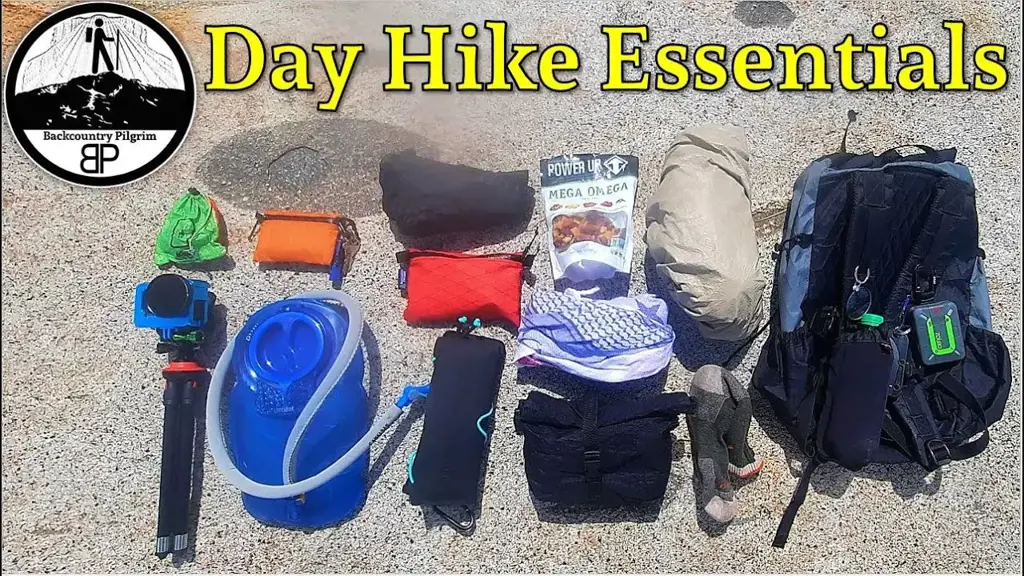
Going on a day hike is a great way to enjoy nature and get some exercise. To ensure that you have a successful and enjoyable hike, it's important to pack the right food and water items. Here are some specific items that you should consider packing for your day hike.
Water is the most important item to have on a day hike. It's recommended that you bring at least 2 liters of water per person for a full day hike. This is to ensure that you stay hydrated throughout your hike, especially if you're going to be exerting yourself. It's best to bring a reusable water bottle or hydration bladder so that you can easily refill it along the way.
In addition to water, you should also pack some snacks to keep your energy levels up. Choose snacks that are lightweight, non-perishable, and provide a good balance of carbohydrates, protein, and fats. Some examples of suitable snacks for a day hike include trail mix, energy bars, dried fruits, nut butter packs, and beef jerky. These snacks are easy to pack and provide the necessary nutrients to keep you going.
If you're planning on eating a lunch during your hike, consider packing some ready-to-eat foods that don't require refrigeration. Some options include sandwiches, wraps, or pre-packaged meals such as burritos or pasta salad. It's also a good idea to bring some fresh fruits or vegetables for added nutrition and hydration.
When it comes to food and water, it's important to pack them in appropriate containers. Look for lightweight and durable containers that won't add unnecessary weight to your backpack. Consider using a combination of resealable plastic bags, lightweight Tupperware, or collapsible water bottles.
It's also worth mentioning that it's important to pack out any waste that you generate during your hike. This includes food wrappers, empty water bottles, and any other trash. Leave no trace means leaving the natural environment as you found it, so be sure to dispose of your waste properly when you return from your hike.
In summary, when packing food and water for a day hike, ensure that you have enough water to stay hydrated throughout the hike. Pack lightweight and non-perishable snacks for energy, and consider bringing ready-to-eat lunch options. Use appropriate containers to hold your food and water, and make sure to pack out any waste you generate. By packing the right items, you'll be well-prepared and nourished for a successful day hike.
What Clothes to Pack for a Carnival Cruise Vacatio?
You may want to see also

What safety items should I include in my day hike pack?
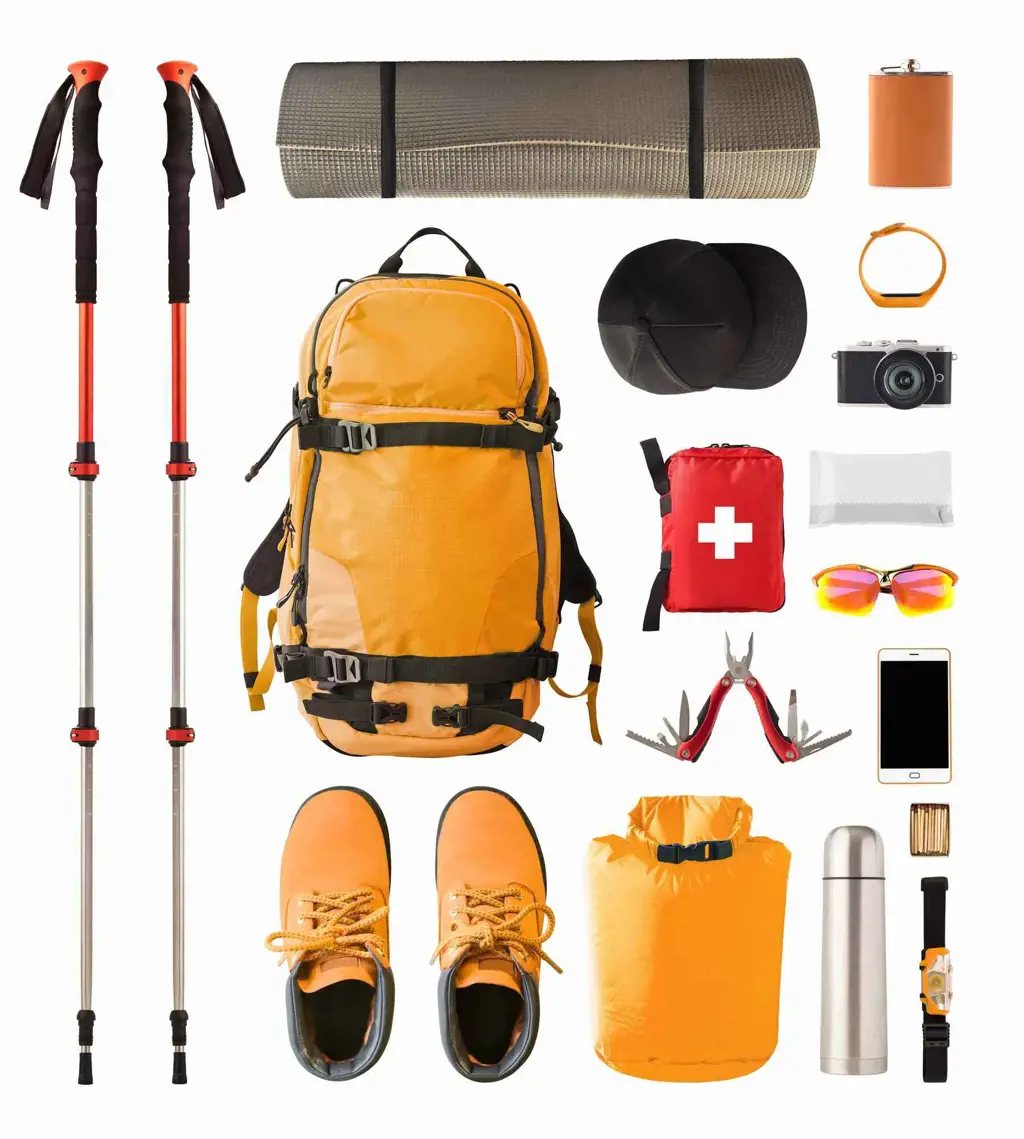
When heading out for a day hike, it's important to be prepared and bring along essential items to ensure your safety. While day hikes may not require as many supplies as longer hikes or overnight trips, there are still several items that you should include in your day hike pack. These items will help you navigate any potential risks or emergencies that may arise during your hike. Here are some safety items that you should consider including in your day hike pack:
- Navigation tools: A map and compass (and the knowledge to use them) are essential for any hike. Even if you plan on following well-marked trails, it's always a good idea to have these tools with you in case you get lost or need to make a detour. Additionally, consider bringing a GPS device or smartphone with a navigation app as a backup.
- First aid kit: Accidents can happen on the trail, so having a small, lightweight first aid kit can be a lifesaver. This should include items such as band-aids, adhesive tape, antiseptic wipes, gauze pads, tweezers, and any necessary personal medications. Take a first aid course before your hike to learn how to properly use these items.
- Sun protection: Spending several hours under the sun can cause sunburn and heat exhaustion. Protect yourself by wearing sunscreen with a high SPF, a wide-brimmed hat, sunglasses with UV protection, and lightweight and breathable clothing that covers your skin. Don't forget to pack lip balm with SPF as well.
- Extra food and water: Even on a short hike, it's important to bring enough food and water to keep yourself nourished and hydrated. Bring snacks that are high in energy, such as trail mix, energy bars, and fruits. Pack enough water to last the duration of your hike, and consider carrying a water filter or purification tablets in case you run out or need to refill from a natural water source.
- Emergency shelter: In case you get injured or caught in unexpected weather, having an emergency shelter can provide protection and comfort. This can be a lightweight tarp or an emergency bivvy sack. Choose one that is easy to set up and fold back into your pack.
- Extra clothing: Weather conditions can change quickly when you're out on the trail. Pack extra clothing layers, such as a lightweight jacket or fleece, to keep you warm. This is especially important if you'll be hiking in high altitudes or during cooler seasons.
- Communication devices: While it's nice to disconnect from technology during a hike, it's important to have a way to communicate in case of an emergency. Pack a fully charged cell phone or a two-way radio, as well as a portable charger or extra batteries to ensure they stay powered.
- Whistle and signaling mirror: These lightweight items can be used to signal for help if you're lost or injured. A whistle can carry sound much farther than your voice, while a signaling mirror can be used to reflect sunlight and catch the attention of search and rescue teams.
- Safety equipment: Depending on the terrain and conditions of your hike, you may need additional safety equipment. This could include trekking poles for stability on uneven terrain, a headlamp or flashlight for hiking in low-light conditions, and a multipurpose tool, such as a Swiss Army knife, for various tasks.
- Personal identification and emergency contact information: Carry a form of identification, such as a driver's license or ID card, in case of an emergency. Additionally, include a small card with your name, emergency contact information, relevant medical information, and any allergies or medications you may have. This will help rescuers provide appropriate care if needed.
Remember, this list of safety items is not exhaustive and may vary depending on your specific hike and location. Before heading out, always research the trail and conditions, check the weather forecast, and let someone know your hiking plans. Stay safe and enjoy your day hike!
Essential Wardrobe Items to Pack for Birthright: A Comprehensive Guide
You may want to see also
Frequently asked questions
When preparing for a day hike, it's important to have a few essential items to ensure your safety and comfort. These include a reliable map and compass, plenty of water to stay hydrated, high-energy snacks or trail mix, a first aid kit for any emergencies, sunscreen and insect repellent to protect against the elements, and appropriate clothing and footwear for the terrain and weather conditions.
It's crucial to stay hydrated during a day hike, especially if you'll be exerting yourself. A general guideline is to bring at least 2 liters (or about half a gallon) of water per person. If you're hiking in hot or humid conditions, or if the hike will be particularly strenuous, you may want to bring even more water. It's better to have extra and not need it than to risk dehydration.
When it comes to food for a day hike, look for snacks that are lightweight, non-perishable, and high in energy. Trail mix, granola bars, dried fruit, beef jerky, and nuts are all excellent options. Avoid foods that are easily crushed or that require refrigeration. It's also a good idea to pack something substantial for a meal, like a sandwich or wrap, especially if you'll be hiking for several hours.
Having a first aid kit with you on a day hike is highly recommended. Accidents can happen at any time, and a basic kit can help you treat minor cuts, blisters, or sprains. Make sure your kit includes bandages, antibiotic ointment, pain relievers, adhesive tape, and any personal medications you may need. It's also a good idea to brush up on basic first aid techniques before heading out on your hike.
Your clothing should be suitable for the weather conditions and the type of terrain you'll be hiking on. Dress in layers so that you can easily adjust your clothing as needed. A moisture-wicking base layer, such as a lightweight t-shirt or long-sleeved shirt, is a good starting point. Over this, you can add a fleece or lightweight jacket for warmth, and a waterproof and breathable outer layer to protect against rain or wind. Choose durable, comfortable pants or shorts, and don't forget to wear sturdy, broken-in hiking boots or trail shoes to protect your feet.







